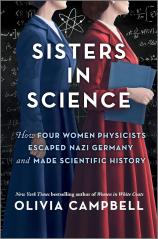Sisters in Science: How Four Women Physicists Escaped Nazi Germany and Made Scientific History
Review
Sisters in Science: How Four Women Physicists Escaped Nazi Germany and Made Scientific History
In SISTERS IN SCIENCE, bestselling author Olivia Campbell (WOMEN IN WHITE COATS) details the personal histories of four dynamic female physicists who rose to prominence in their time. However, they were forced to flee Hitler’s Germany in harrowing, sometimes life-threatening conditions because of their Jewish connections.
Campbell makes clear that each of these women already had overcome many barriers, both subtle and stated, simply because of their gender. In the 1930s, not only in Germany but across the globe, women were not expected to excel in the academic realm, especially the sciences. Many universities had no accommodations for women, not even bathrooms. But worse for Lise Meitner, Hedwig Kohn, Hertha Sponer and Hildegard Stücklen was their Jewish heritage, at a time when the newly rising Nazi regime considered someone with even one Jewish grandparent to be fodder for the concentrations camps and certain extermination. Fear for their fate forced them to depart from their homeland.
"After diligently delving into this account of women’s place in the complex realms of higher study, Campbell sagely concludes, 'Women scientists deserve so much better.'"
Meitner lost her position, assiduously gained despite bias against her gender, as a Physics professor in Berlin and managed to flee to Sweden, where she became a citizen and would be nominated numerous times for the Nobel Prize in her field. Kohn, whose specialty was intensity of light and its relation to atoms and molecules, went to Switzerland and then the US. She taught at the University of North Carolina and Wellesley College in Massachusetts, and initiated a research lab for flame spectroscopy.
Sponer, who published many scientific papers and was among the small number of women able to obtain a PhD in Physics, was summarily dismissed from her professorship, escaped to Sweden, and later found prestige and recognition in America at Duke University. Stücklen was a lecturer at the University of Zurich until threats of deportation back to Germany arose, so she made her way to the US to teach physics at Sweet Briar College.
One element of these dramatic, sometimes hour-by-hour sagas that Campbell brings vividly to light is the reluctance of many American institutions to accept these deserving, brilliant women, ostensibly because of fears of wartime subterfuge. Additionally, the pervasive anti-Jewish sentiment at the time is evidenced by the disturbing fact that, as Campbell strictly reports, shortly after Kristallnacht, a Gallup poll showed that 72 percent of Americans would not choose to accept Jewish immigrants to the US. These exceptional ladies struggled to adjust to their new, safer situations abroad, all while energetically demonstrating their academic prowess. All would succeed and innovate in their fields while keeping in touch with one another.
After diligently delving into this account of women’s place in the complex realms of higher study, Campbell sagely concludes, “Women scientists deserve so much better.”
Reviewed by Barbara Bamberger Scott on January 10, 2025
Sisters in Science: How Four Women Physicists Escaped Nazi Germany and Made Scientific History
- Publication Date: December 31, 2024
- Genres: History, Nonfiction
- Hardcover: 384 pages
- Publisher: Park Row
- ISBN-10: 0778333388
- ISBN-13: 9780778333388




